Famed for his defensive tactics, Diego Simeone and his Atlético Madrid side have only conceded once this season.
More impressively, they’re top of the scoring table, too.
The caveat is that seven of those 10 goals came against Rayo Vallecano, so the per-game average is skewed, but since the 2023 World Cup break, no La Liga side has scored more goals than Simeone’s Atleti.
What has sparked this change?
In this tactical analysis, we explore some of the attacking principles Atlético Madrid has applied this season under Diego Simeone’s coaching style.
Discussing Atleti’s attacking production is intrinsically linked to their defensive tactics, so we’ll start there before a scout report of their attacking principles.
diego simeone Defensive tactics are the starting point
Like it or not, Simeone’s reputation is directly connected to his side’s fierce defending and his pragmatic approach.
Though with some adaptation across his years as the manager of Atlético Madrid, it’s their defensive identity and quick counterattacking that routinely receive praise.
Working in those facets of the game has allowed them to perform above their weight both domestically and in Europe.
Defensively, they’re as strong as ever.
Tactical analysis of Atlético Madrid’s attacking is intrinsically tied to the way they defend under Diego Simeone’s tactics.
Their work at a possession creates many of their best attacking opportunities.
This is classic Simeone ball.
Compared to last season, particularly before the World Cup break, there are noticeable changes in the way Atlético engages opponents.
Comparing the small sample from the season to the last campaign, Atlético is averaging approximately 2.5 fewer counter-pressing recoveries per game, another 2.5 high recoveries fewer and 2.3 fewer dangerous recoveries.
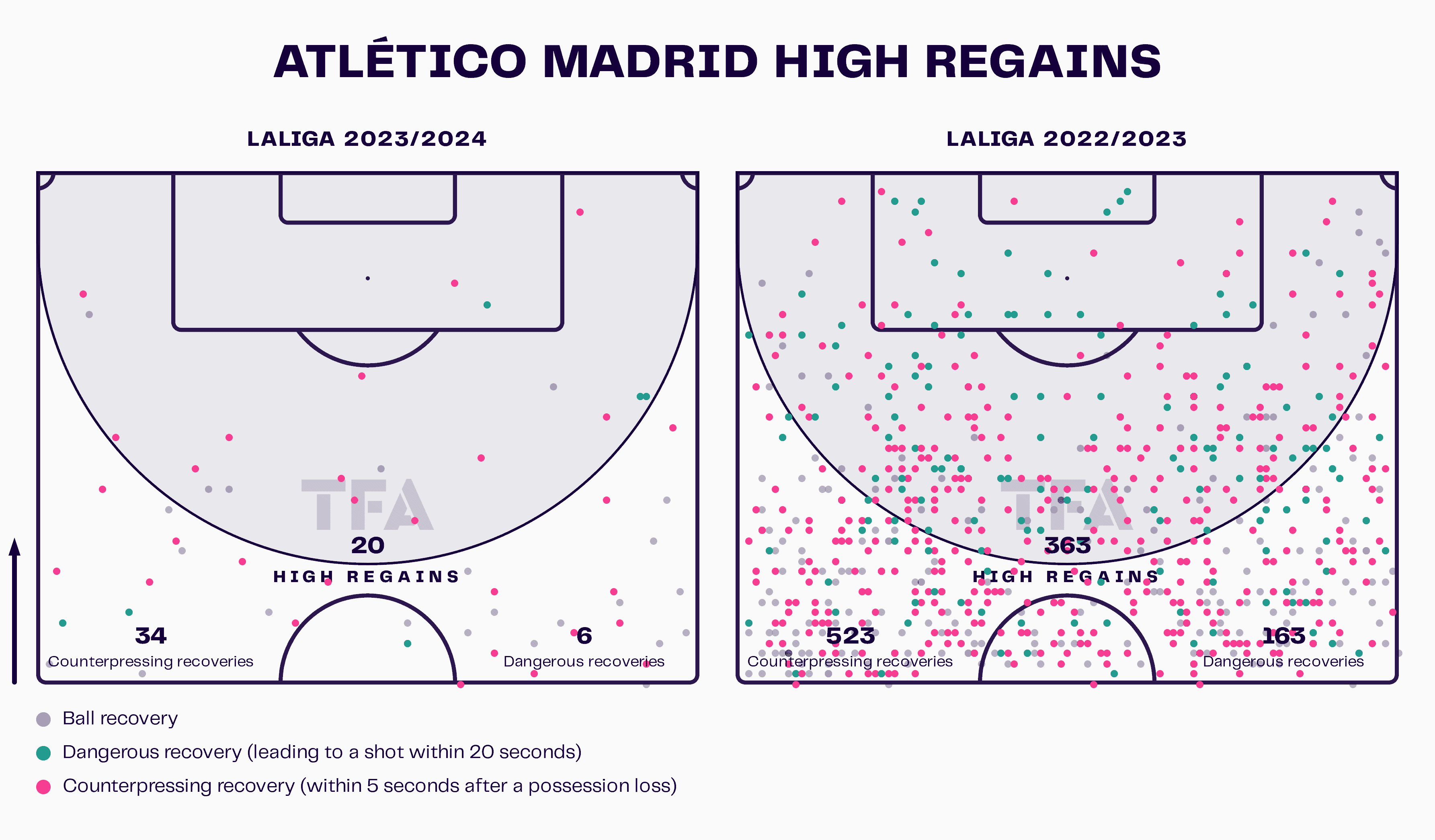
In terms of defensive territory, there’s not much difference in the width they are covering nor how deep an area their defensive territory covers.
The most significant differences are in the top of that pressing area and the slight improvement in the height of recoveries.
Atlético’s defensive territory is deeper than last season, but they are recovering the ball higher up the pitch.
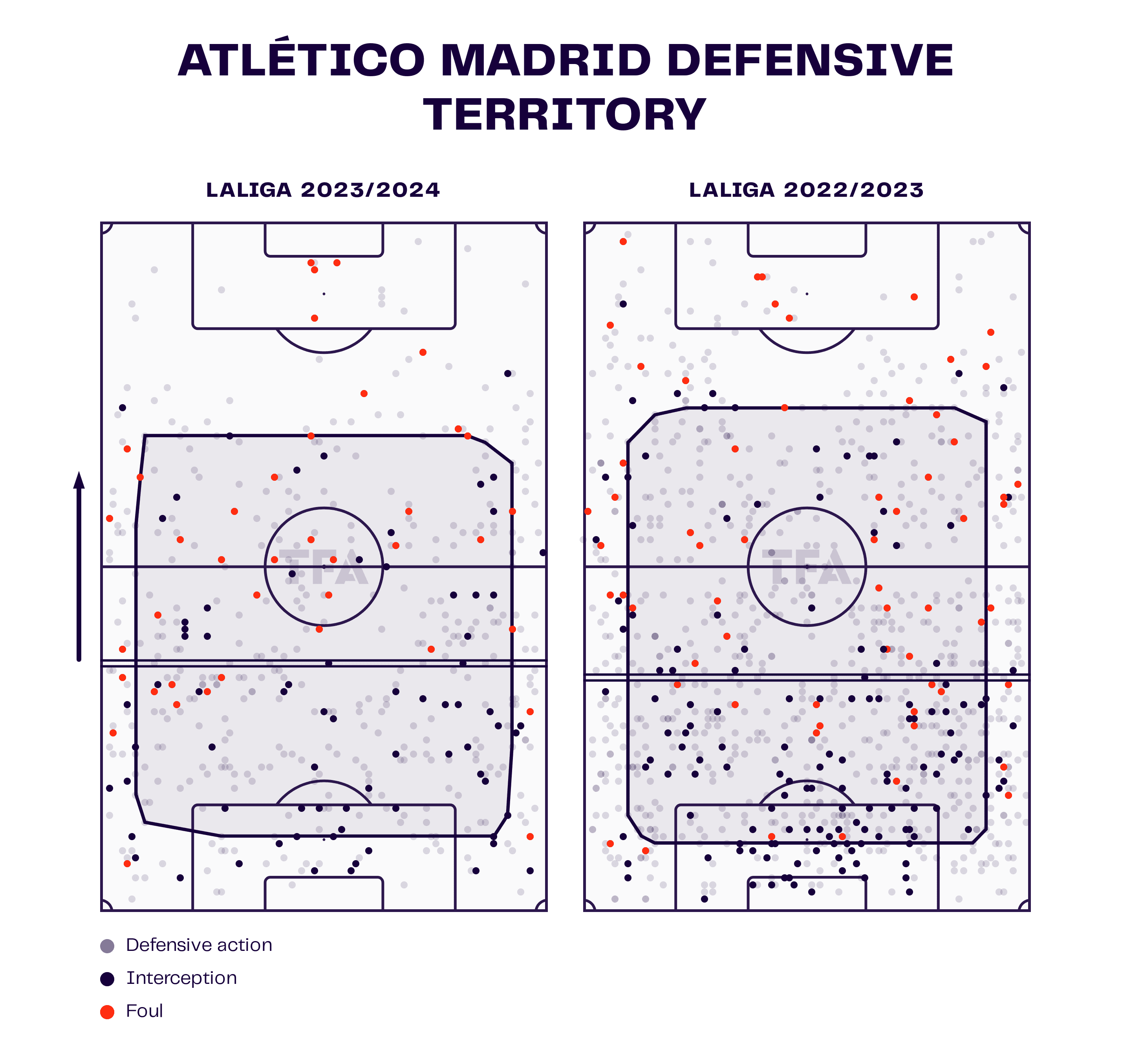
There is a commitment to putting pressure on the opposition’s build-out, though it is with limited numbers.
With those few players providing excellent pressing structure and phenomenal intensity to close down the first attacker and his supporting network, the objective is to force opponents to play long into the forward line.
That’s where Atlético Madrid is finding their success.
They may not have as many high recoveries in the average match as they did last season, but the pressure in the high press is resulting in mid-recoveries.
Atlético routinely wins the first and second balls, allowing them to restart their attack from higher up the pitch.
The added advantage is that once the ball is recovered, their most advanced players are tightly connected and typically in central positions.
Atlético will look for an early pass into the forward line and use those three or four tightly connected players to attack in numeric equality.
For example, against Real Betis, a recovery on the right led to one pass centrally and then a ball over the press into the forward line.
Memphis Depay offered a run behind the backline, but the pass was short, immediately cueing Álvaro Morata to drop into a support position underneath.
As they retained possession in that 2v2, Antoine Griezmann sprinted forward to offer an overlapping run, getting the three attackers into the Betis box.
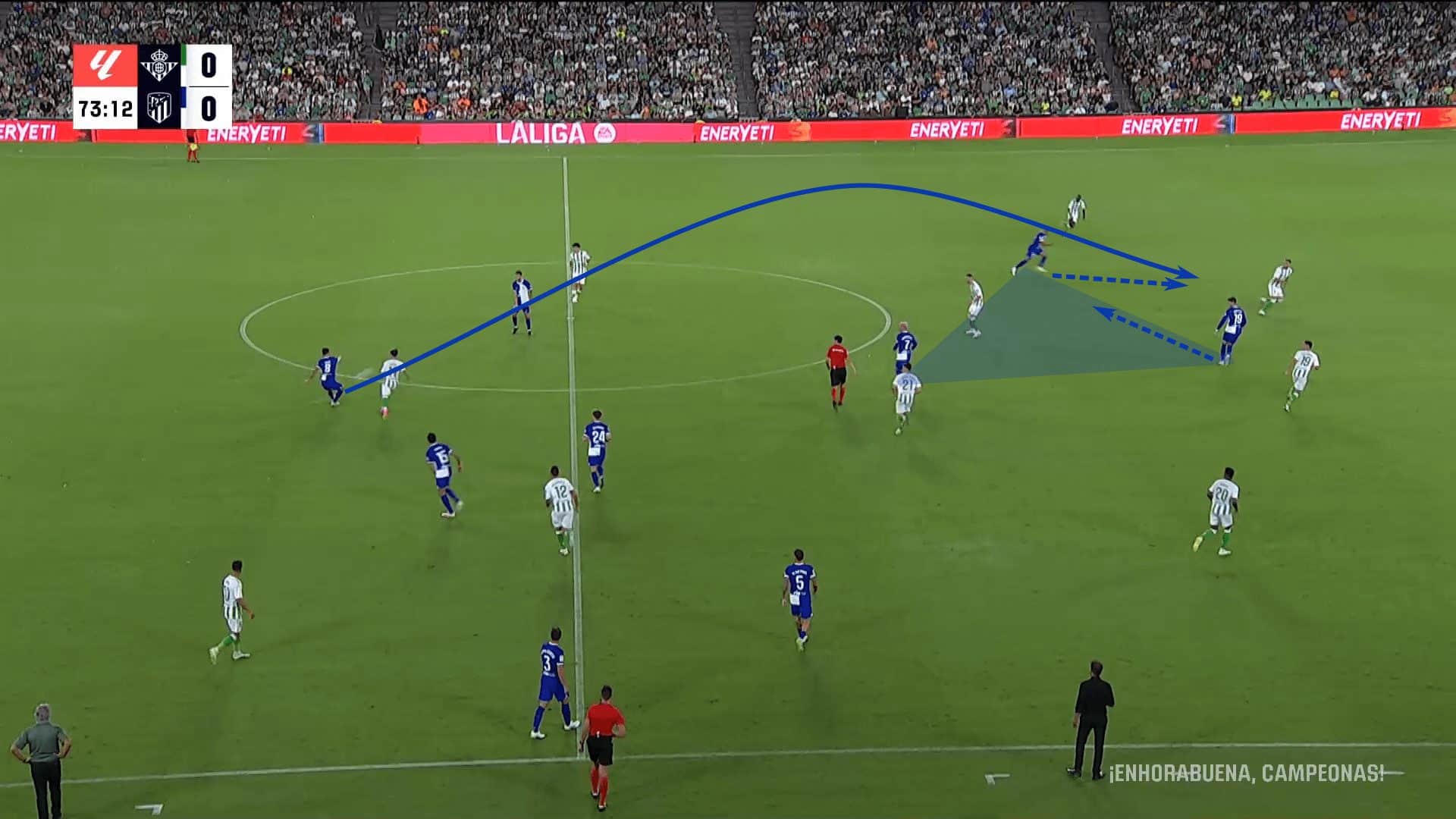
When the midfield recovers the ball or the first pass can be played into them quickly, this Atlético Madrid side is very good at getting runners between the lines with the ball on their feet and forward-facing positions.
That allows them to drive at the opponent’s backline as the opposition’s defenders gradually retreat towards the goal.
The tempo of these attacks is critical.
Not allowing the midfield to recover their shape and forcing the backline to step to the ball eventually are key components to Atlético Madrid’s counterattacks.
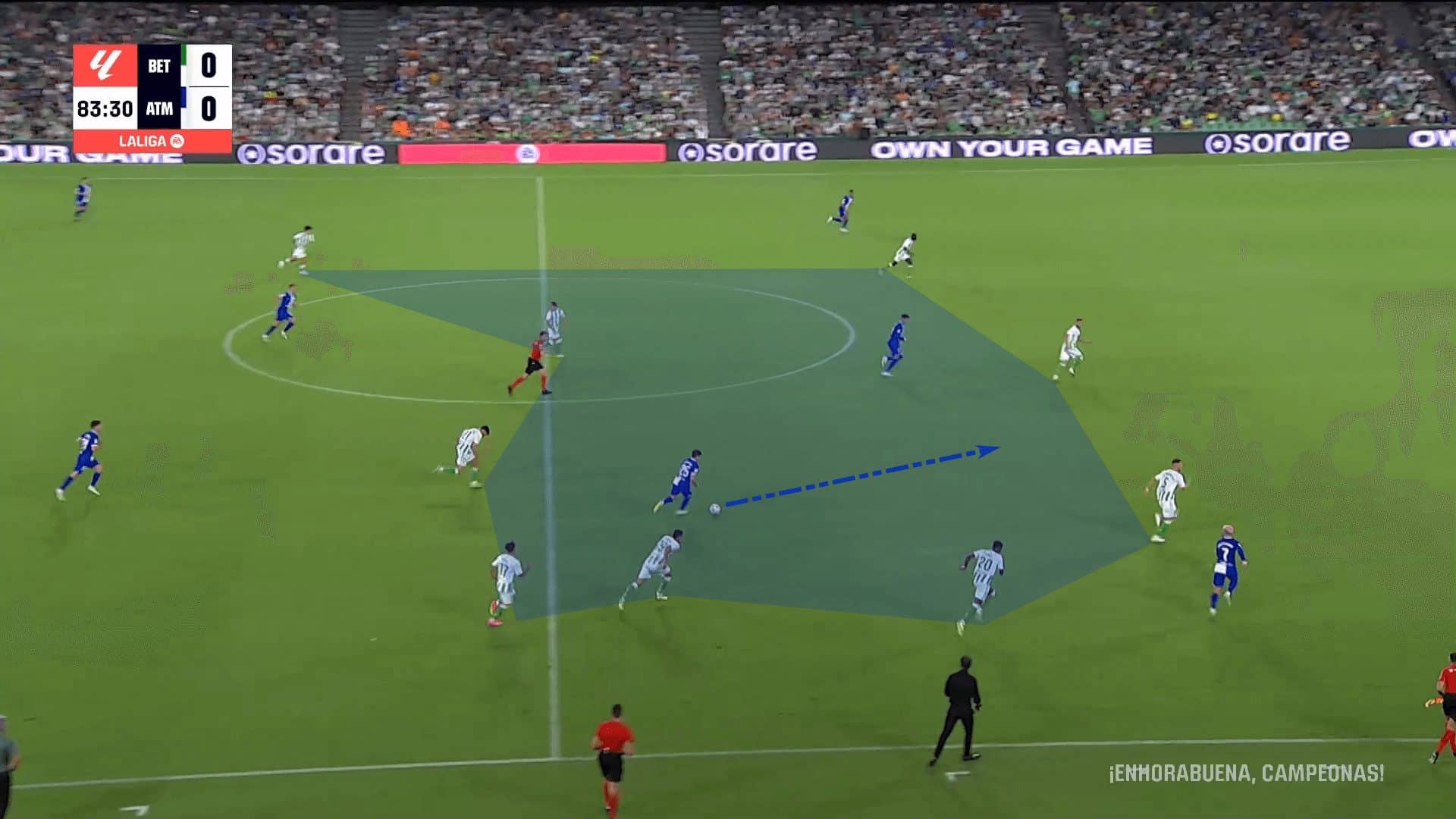
Once they engage the backline, the first attacker is clearly targeting one of the opposition’s centrebacks.
In running at the centreback, the objective is to pull him forward, creating a running lane in behind.
The centreback’s forward movement is the visual cue.
As he steps forward, the ball is played behind him, and the runner, who was targeting that movement from the start, bursts behind the backline.
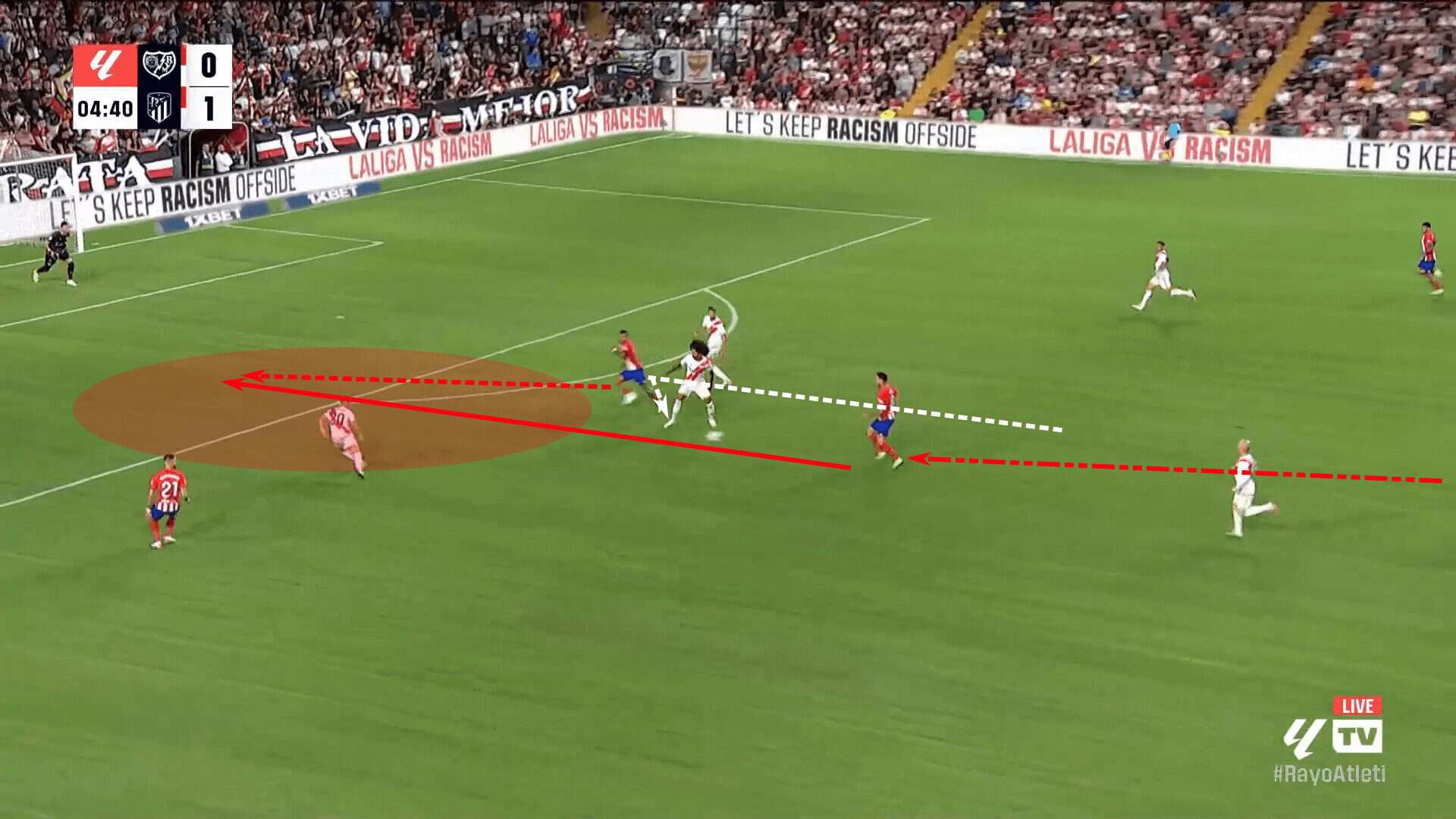
Those simple, weighted through passes routinely get the Atlético Madrid forwards behind the opposition’s backline and into high-quality goal-scoring positions.
Morata, Griezmann and Depay are all willing to make those runs off the ball.
Griezmann is especially good at starting in a deeper position and reading the movements of the players in front of him.
The result is untracked runs into the box.
This section is classic Simeone tactics.
Defending structure that creates counterattacking opportunities has always been his speciality.
This iteration of the Colchoneros is true to form.
But this side is more than just a counterattacking team.
Let’s turn our focus to their attacking tactics in open play.
Asymmetric attacking structures
Simeone’s Atlético Madrid has never had the reputation of a team with indirect possession.
When they have the ball, they do look to break lines quickly and create high-tempo direct possessions, which we have covered in a previous analysis.
In terms of pure possession numbers, last season’s team averaged 47.88% of the ball per match.
Due to the small sample size of the 2023/24 campaign, that number has fallen to 43.74%. Grenada, Real Betis, and Rayo Vallecano have all out possessed Atleti, but Simeone is not focused on possession totals.
Diego Simeone’s attacking tactics aren’t burdened by the data.
One of Diego Simeone’s tactical evolutions is the use of asymmetric attacking structures to unbalance opponents.
His side has put this principle play in all three of their matches this season.
Against Real Betis, we saw a great example of high and low overloads on opposite sides of the pitch.
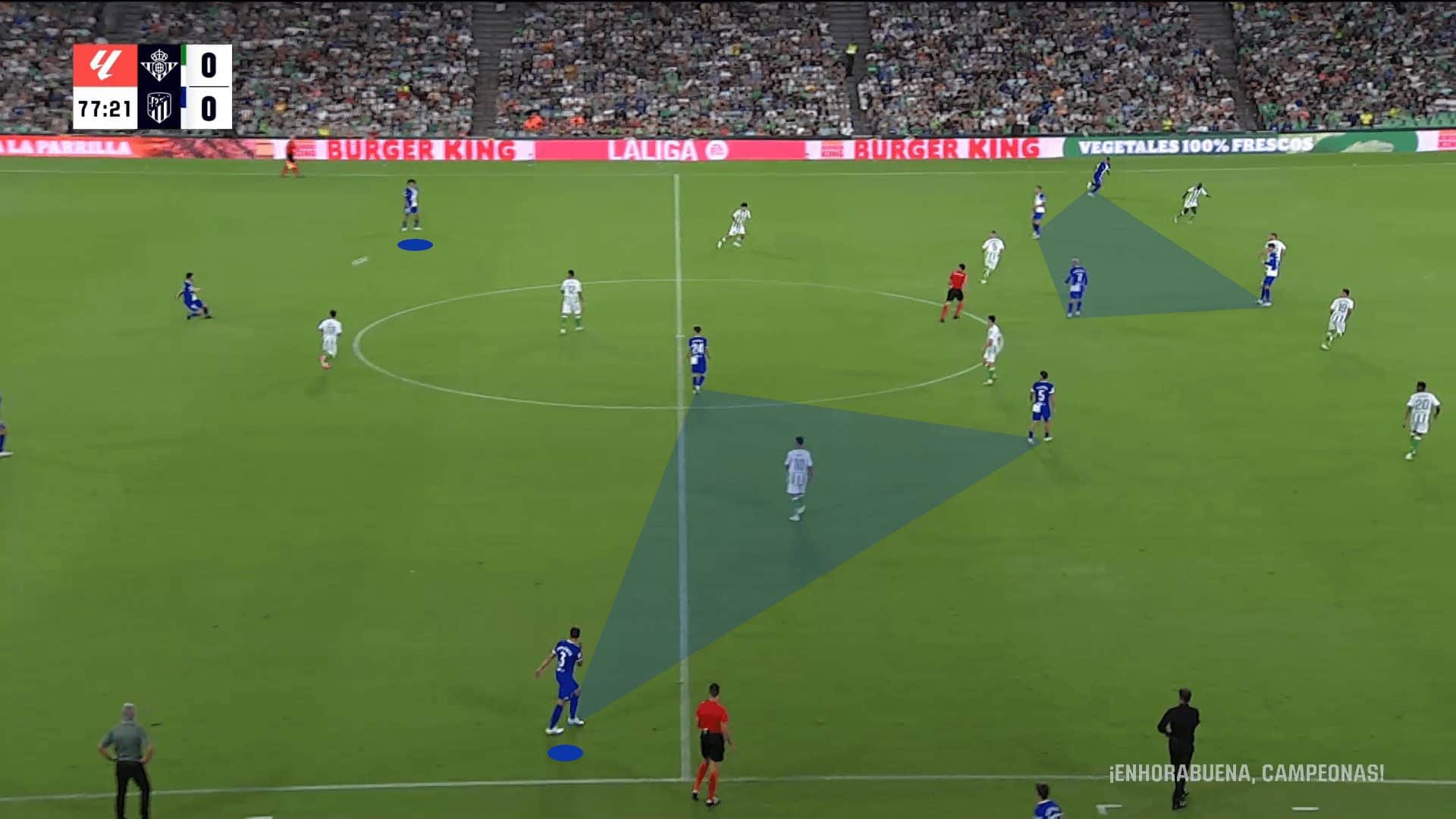
The connection with the wide centre-backs is very important.
Notice that the low overload features two players supporting the right centreback, while the high overload offers passing lanes for the left centreback.
If the opposition drops deep to account for the players in the high overload, there is space for the wide centreback to drive forward, pulling the opposition press forward and creating more space for the second and third attackers in the high overload.
They don’t necessarily prioritise one side for the high overloads, either.
This is a squad that is equally comfortable creating that structure on the left or the right.
The opening match against Granada provided an excellent visual.
While the left centre-back has plenty of support while operating as the first attacker, Atlético Madrid was well positioned for the switch of play with four players high on the right side of the pitch.
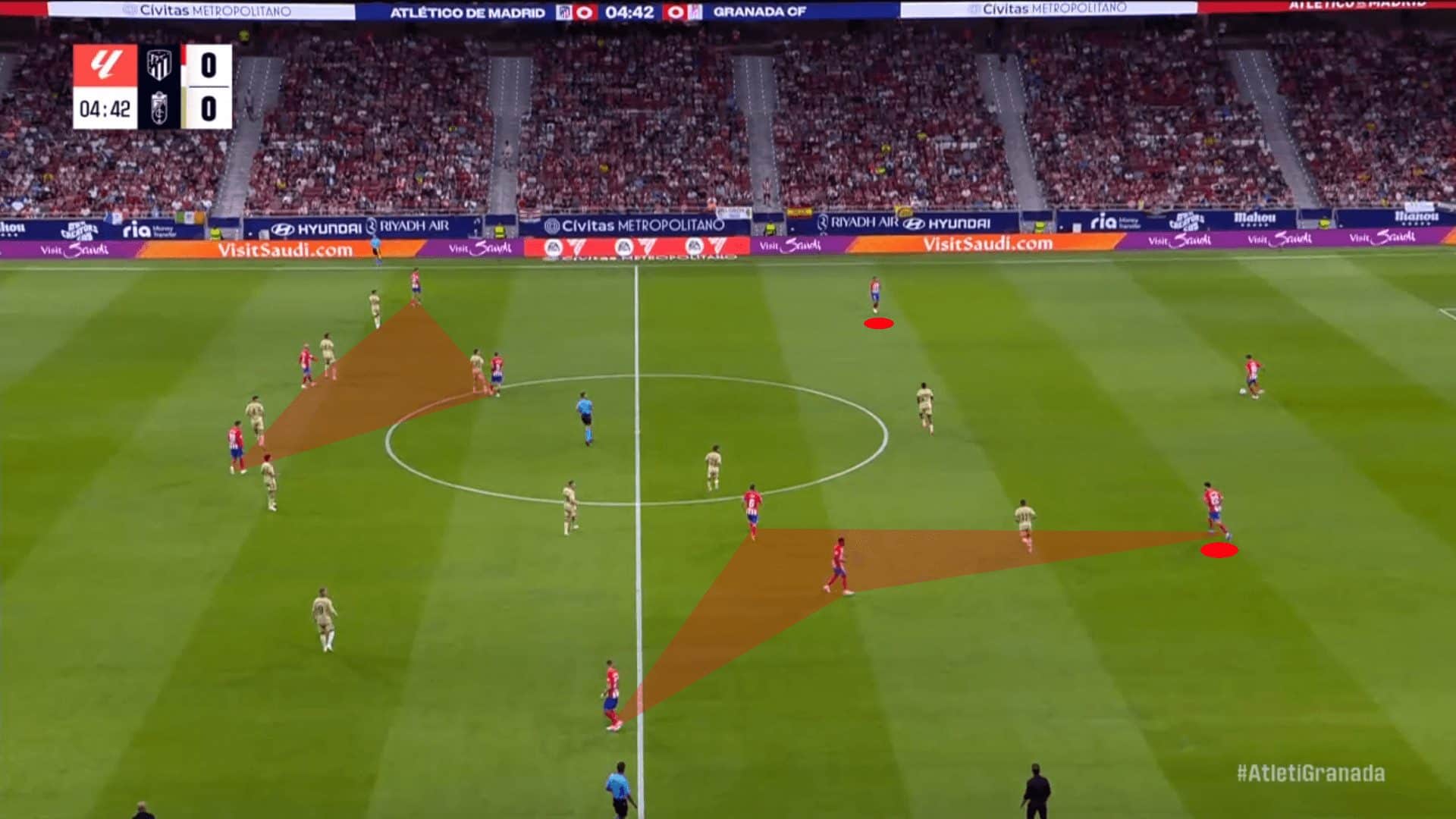
Given Atleti’s positional advantages, the opposition has to respect the low overload because if Atlético Madrid can play through to the high overload on the far side, they have three or four runners from that lower group ready to make their moves into the box.
If the high overload is unaccounted for, then early balls behind or switches of play can create the direct attacks that Atlético Madrid enjoys so much.
The two groups operate in very distinct manners yet are so closely connected in Atleti’s tactical execution.
Once Atlético plays into the high overload, they have the flexibility to go directly to goal through quick combination play or put a foot on the ball and slow the tempo.
Slowing the tempo allows the players in that low overload to make their way into the box as options for a cross, but even here, it’s not necessarily a distinct pattern of play.
The service into the box is typically on, but Atlético will also look to use their numeric equality or superiority near the ball to attack the half-space of the box.
One common movement is for Morata or Depay to offer an initial run and then check back to the ball.
As they check to the ball, Griezmann plays off of their movement to offer a run behind the line.
That creates a better serving situation or even a shot for the Frenchman.
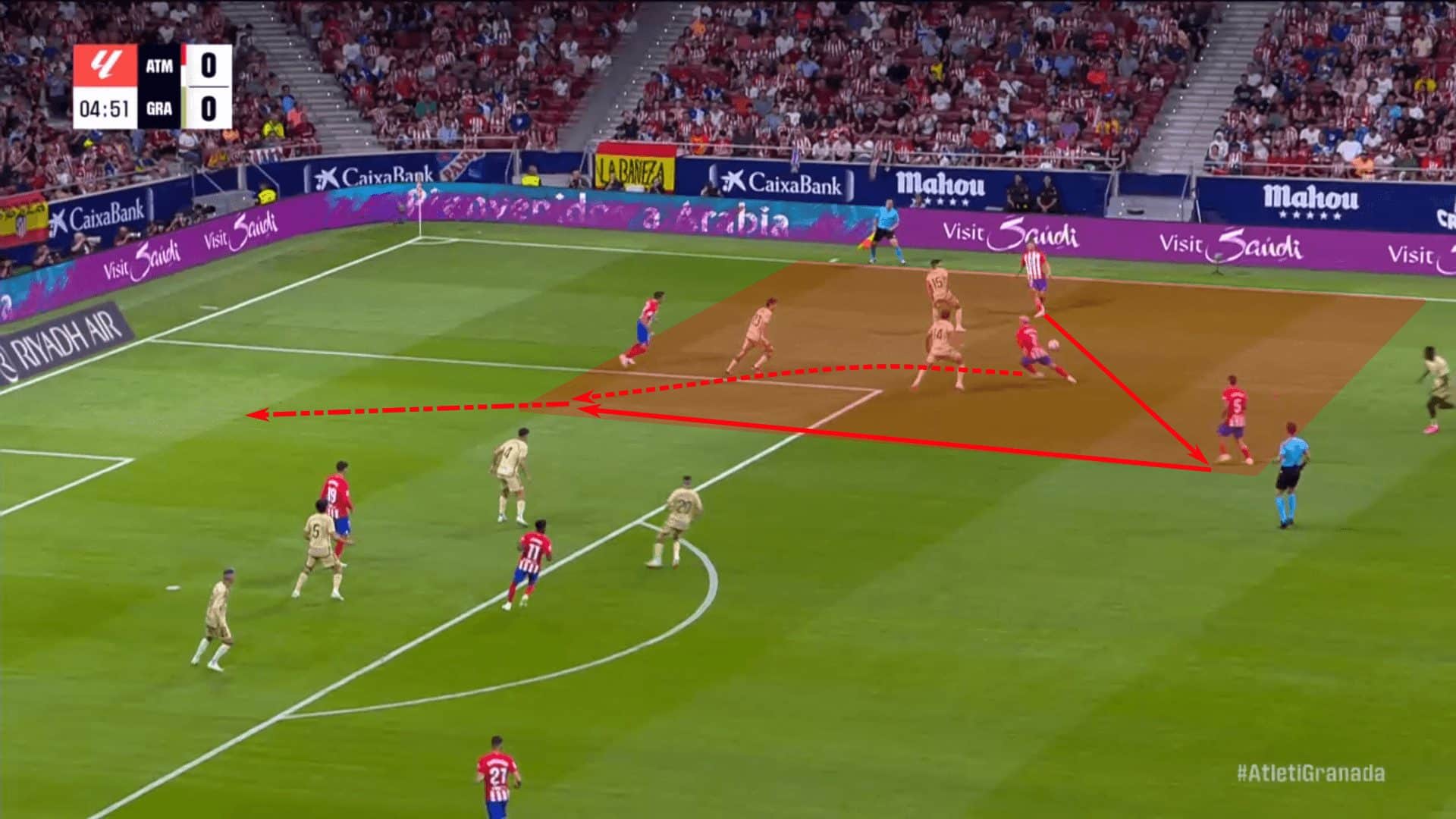
If they are in possession higher up the pitch, especially in the middle third, Atlético will look to occupy three or four of the opposition’s backline.
As the wingers push up, that will force some adaptation from the back line, typically causing them to be stretched horizontally.
In this instance, it’s the Real Betis right back who gets drawn into the wings.
Though Morata is offsides, his initial starting position kept him central, widening the 2/4 gap for the early through ball.
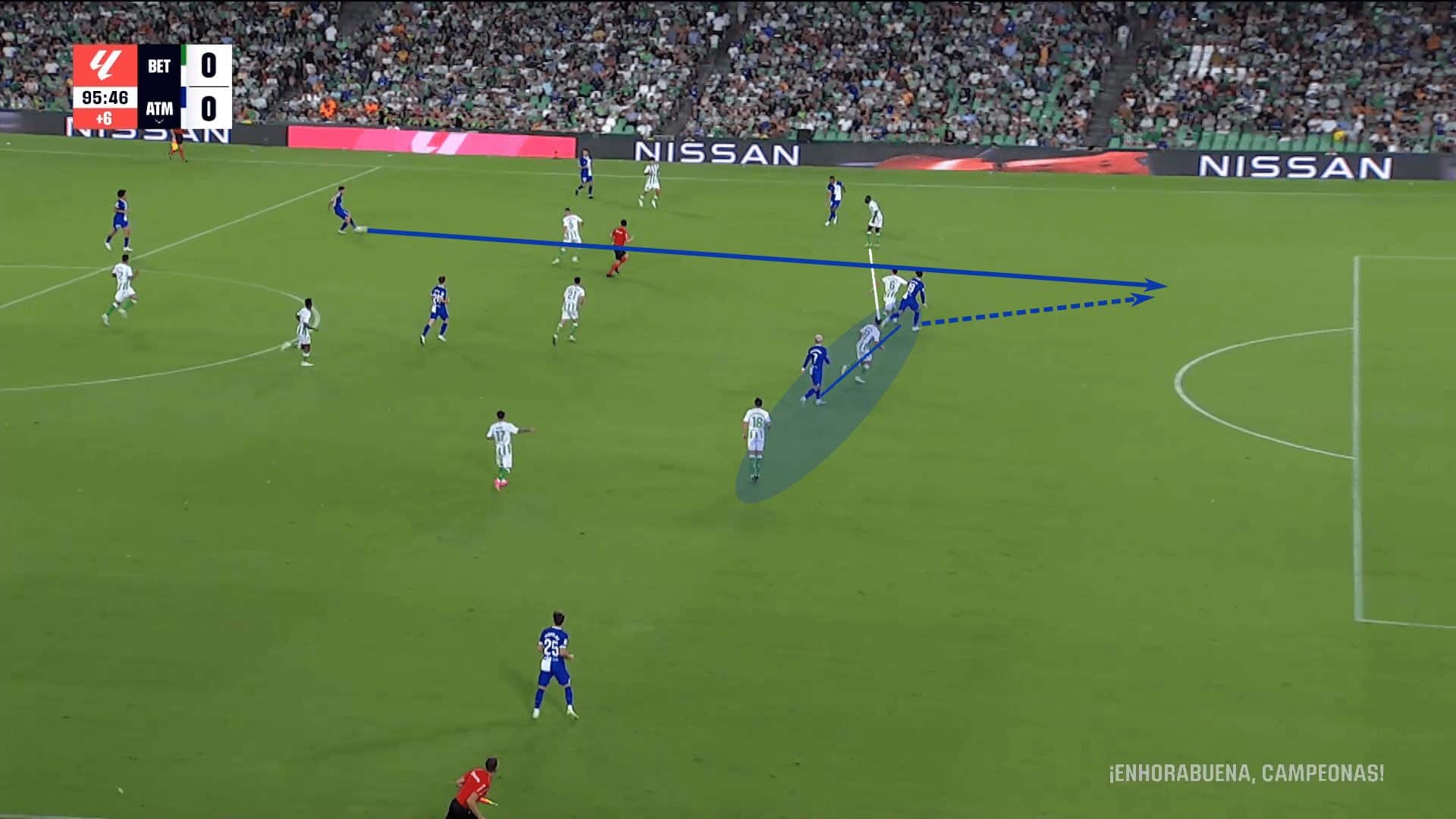
To round off the attack, Atlético Madrid has the definitive central focus as they prepare to attack the box.
They get numbers into the box very well, which plays a crucial role in finishing their chances.
Especially in more directed attacks, they show a high degree of trust in the wide players to bring the ball up the pitch and will only give as little support as the first attacker needs to continue the attack.
Otherwise, the remaining players in the attack are highly focused on getting into the goal zone to attack the impending service into the box or to look for rebounds off of shots.
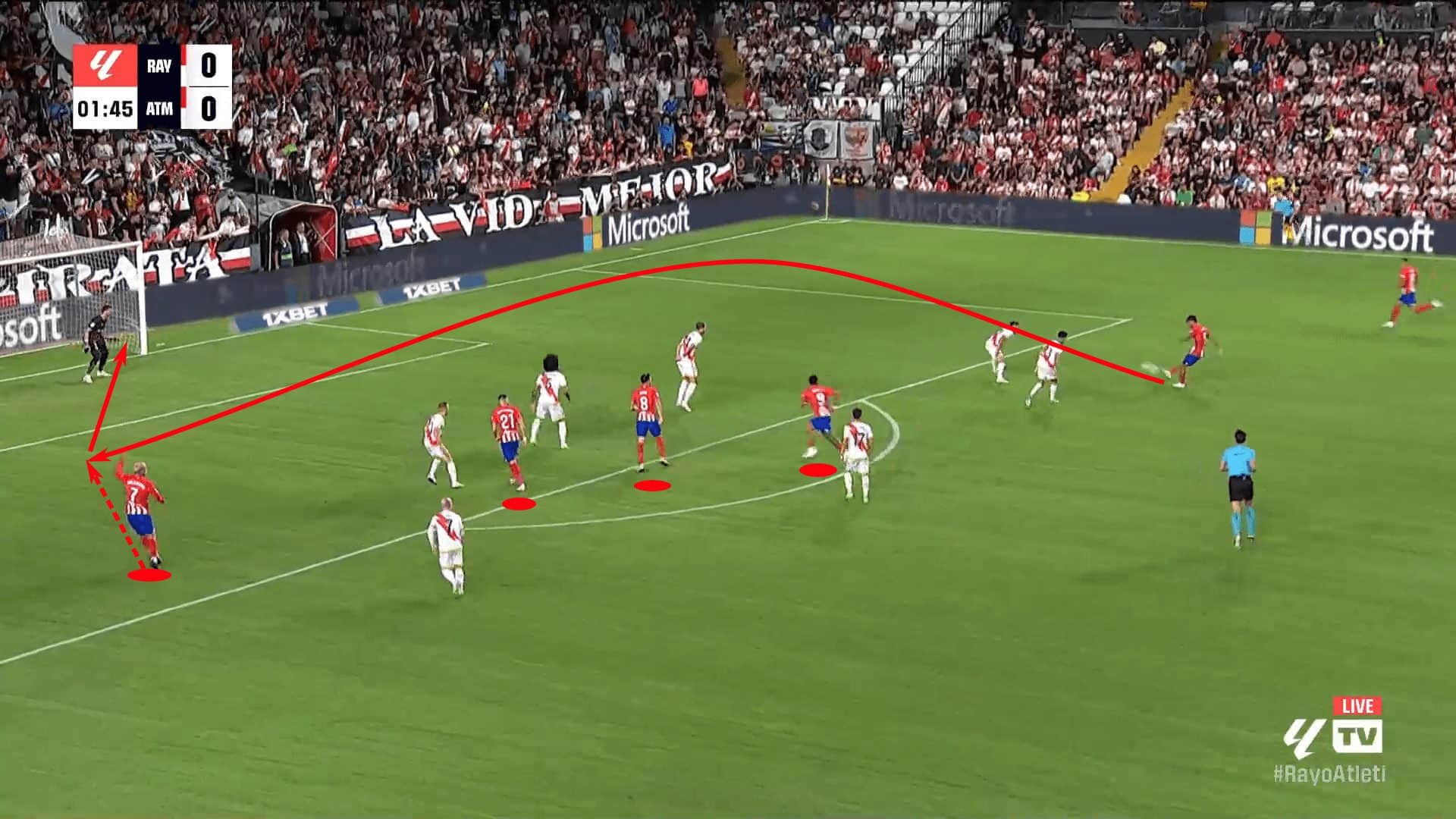
Asymmetric numerical location in each phase of attack and in transition poses unique problems for opponents.
This is a cohesive Atlético Madrid side, so allowing them to play into their numeric equality or even superiority is incredibly difficult to stop, even for the top sides in Europe, let alone the smaller clubs in La Liga.
The sheer tempo of the attack will pose trouble for the likes of Real Madrid and Barcelona this season.
Add in the asymmetric numbers to unbalance the opponent’s defensive shape, and we can see why Simeone’s Atlético Madrid has had so much success scoring goals this calendar year.
Extending the lines vertically
Roberto De Zerbi‘s Brighton has taken the football world by storm.
Analysis of their tactics is widespread, and so were the implementation of his core ideas across Europe.
While Simeone hasn’t replicated the entirety of De Zerbi’s attacking principles, there are some ideas in play with the way Atlético Madrid structures their attack.
The most obvious of which are the rest defence structures and distances between the lines.
The 3-2 build-out structure is widespread in football tactics, especially among the top build-out sides in the game.
While playing through the opposition’s high press carries some risk, a 3-2 or 2-3 structure safeguards the attacking team in case of a low loss.
The structure allows for a quick transition to defence and limits opportunity centrally.
This Atlético Madrid side applies those principles.
Highly structured in the build-out, they reduced risk by limiting the number of passes connected at the back.
Since fewer passes are connected at the back, there’s a shift in focus, and they target the opposition.
While they do want to draw the opposition higher up the pitch to create space between the lines, the positioning of the 3-2 is designed to influence the positions the opposition takes up.
Widening the gap between the three centrebacks and the two central midfielders invites the opposition’s forwards to step higher up the pitch and forces the opponent’s midfield to step to Atlético’s double pivot.
That creates more space for Griezmann to operate between the opponent’s backline and midfield.
It also allows the two wingers to push higher up the pitch, drawing the attention of the opposition’s outside-backs.
Right from the start, the opposition is stretched vertically and must be wary of wide threats.
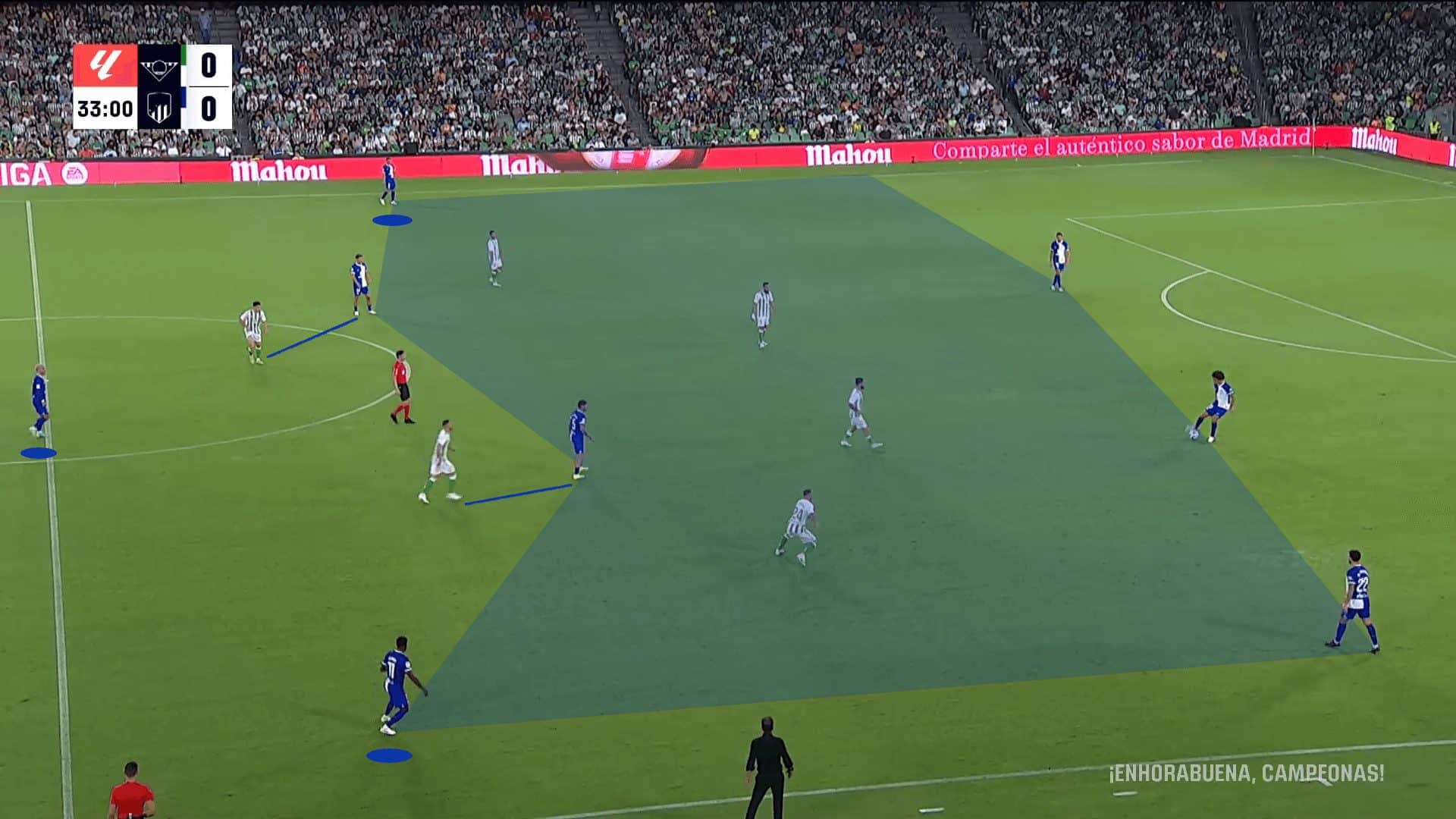
That distance between the lines is compatible with the idea of asymmetric attacking structures.
In the specific example against Real Betis, that high overload was on the left side of the pitch.
In this instance, Atlético played into the wing, leading to both sides shifting near the ball.
Betis sealed the visitors into the wing, yet Atlético was able to retain possession and offer a press-beating pass centrally.
One additional note is the space on the other side of the pitch.
The switch of play is on.
All that remains is for Atlético Madrid to play out of the press.
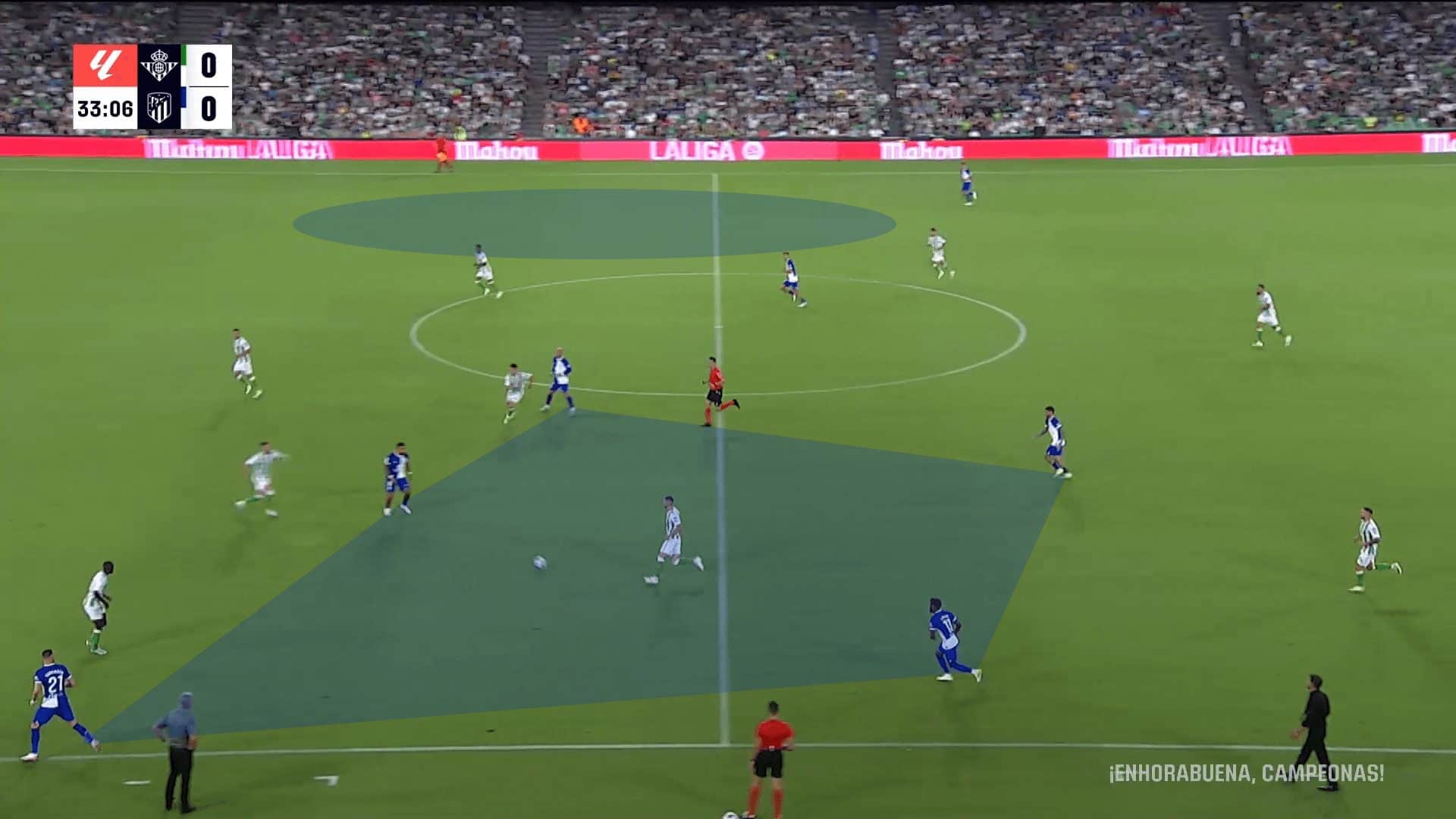
They do manage to switch the point of attack, and there’s an immediate shift in the numbers offering support on the right side.
But notice not everyone goes.
The team is still highly connected near the ball and centrally as they look to attack the goal.
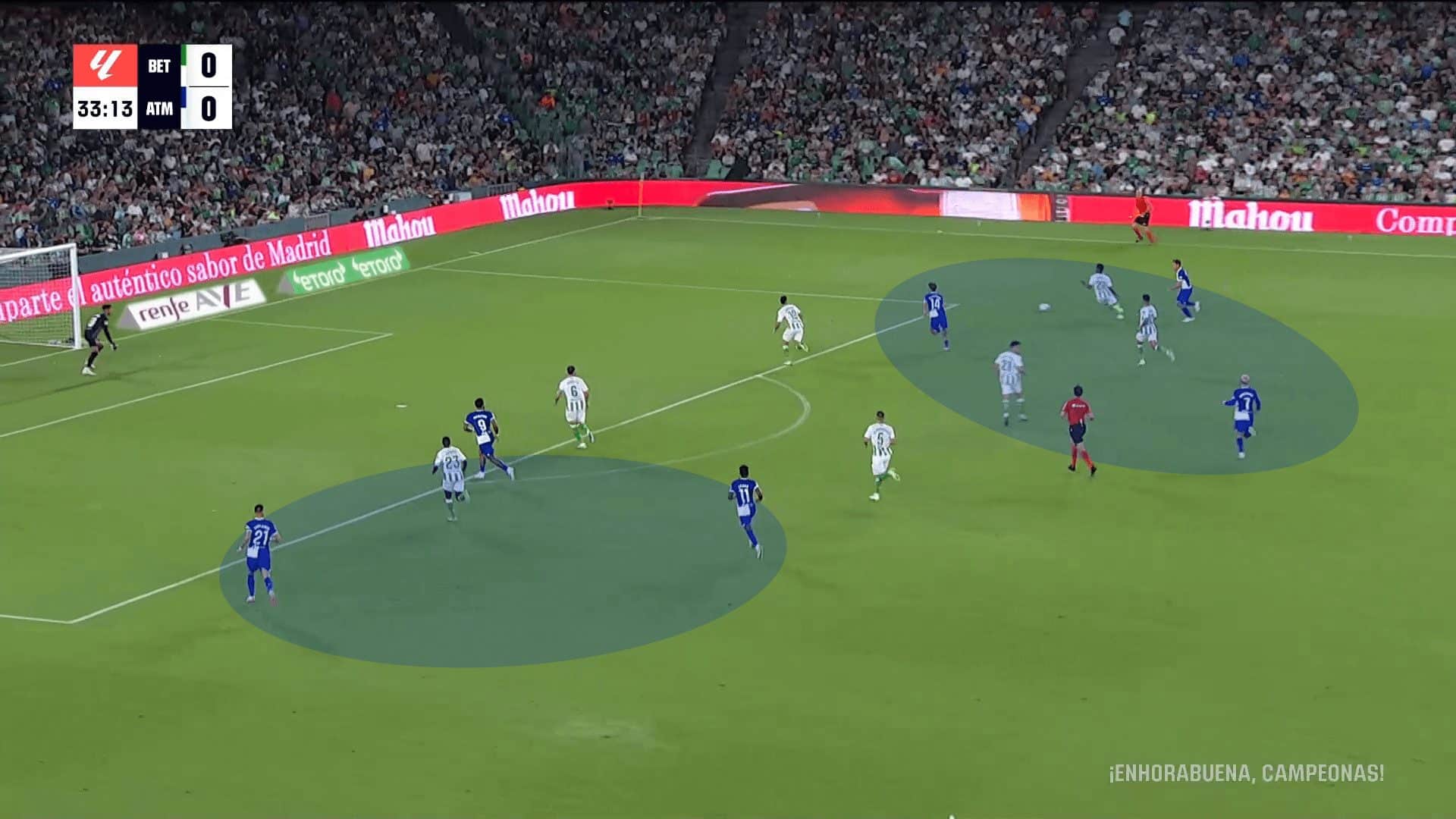
The killer pass isn’t on, so the Colchoneros show good patience and play negatively, but the work isn’t finished.
The initial run behind the line wasn’t played, but Depay cleverly tailored his run to move closer to Griezmann and pull the nearest centreback towards himself while checking towards the ball.
Immediately, Griezmann reads his teammate’s movement and darts behind the line, receiving a fantastic pass and taking his shot.
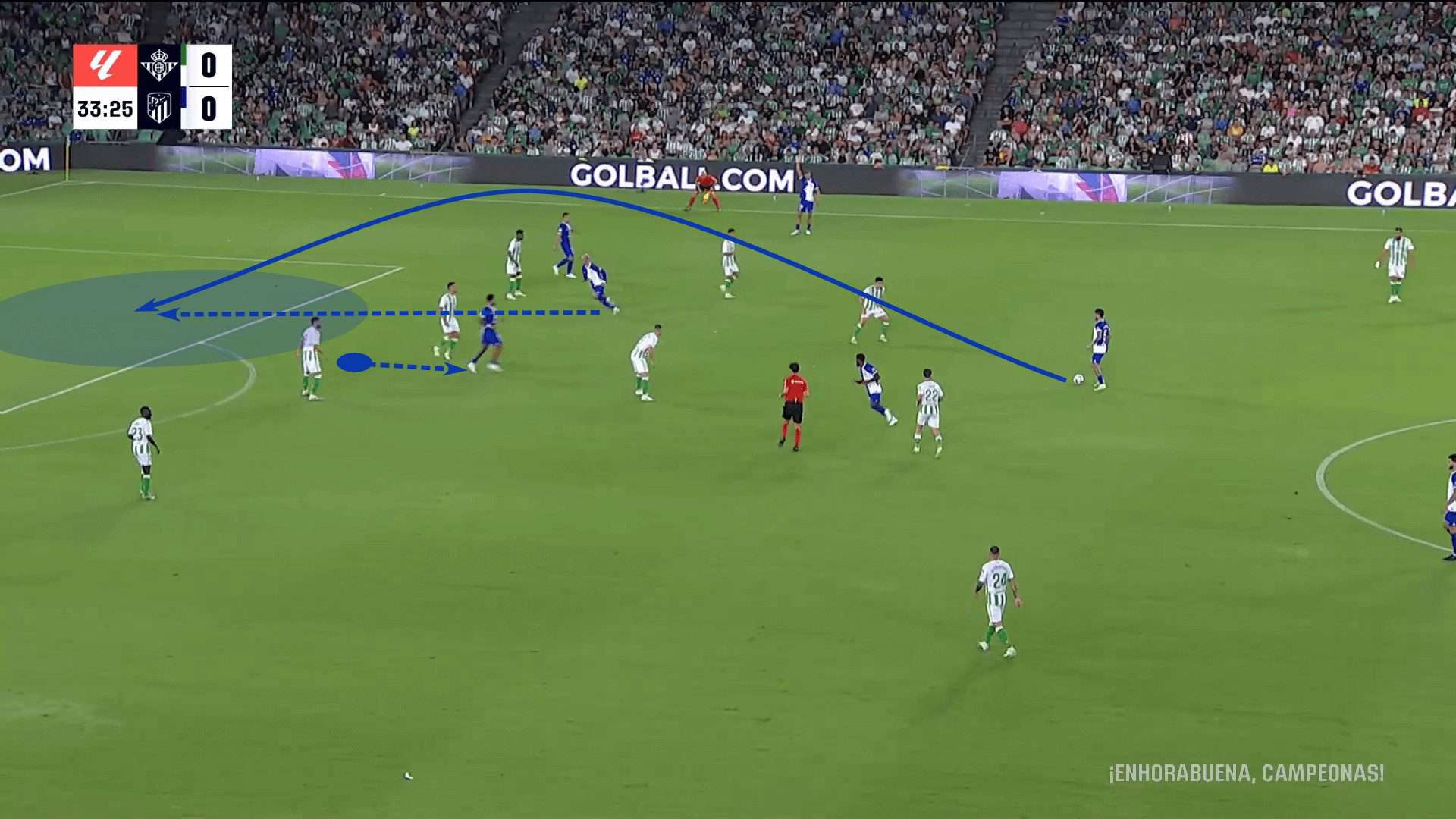
It’s a subtle method, but the deep central defenders and the intelligent positioning of the double pivot create more space for Griezmann between the lines, give more freedom to the wingers to operate outside of the opposition’s midfield press and allow the forwards to create that high overload in the wings to pin the opposition’s backline higher up the pitch.
Much like that last sentence, there’s a lot going on, and it’s challenging to keep track of the different tactical nuances in play.
Stretching the opposition and creating those high overloads was creating more goal-scoring opportunities for Atlético Madrid.
Perhaps more importantly, they are high-quality goal-scoring opportunities as well.
The beauty of the idea is that when they play some of Europe’s top sides in the UEFA Champions League, there’s an understanding that they will have fewer chances on goal, but this tactical setup should continue to produce high-quality chances.
Conclusion
Atlético Madrid may have less of the ball than in previous years, but there is a sense that this squad is closer to the peak Simeone teams of 2013-2017.
That same commitment to the defensive phases of the game is present, but it’s the structure of the team’s attack that will propel the club forward.
Atlético Madrid’s asymmetric attacking structures and the positioning of their lines pose a unique problem for opponents to solve.
It’s not as simple as negating the high central overload because there’s enough quality on the other side of the pitch to progress through the low overload.
Even sealing this team to one side is remarkably difficult.
There’s enough talent for them to unbalance the opponent near the ball and then create the switch of play and a more direct possession.
Atletico Madrid was one of the best teams in the world in the second half of last season.
With a clean slate in 2023/24, they have their opportunity to push for the top of the table and contest the La Liga favourites, Real Madrid and Barcelona.





Comments